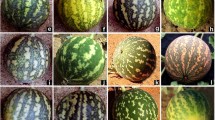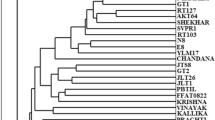Abstract
Thirty Portuguese and eight foreign olive (Olea europaea L.) cultivars were screened using Random Amplified Polymorphic DNA (RAPD) and Inter-Simple Sequence Repeat (ISSR) markers. Twenty RAPD primers amplified 301 reproducible bands of which 262 were polymorphic; and 17 ISSR primers amplified 204 bands of which 180 were polymorphic. The percentage of polymorphic bands detected by ISSR and RAPD was similar (88 and 87%, respectively). The genetic variability observed was similar in the Portuguese and foreign olive cultivars. Seven ISSR and 12 RAPD primers were able to distinguish individually all 38 olive cultivars. Twenty specific molecular markers are now available to be converted into Sequence Characterised Amplified Region (SCAR) markers. Relationships among Portuguese and foreign cultivars is discussed.
Similar content being viewed by others
References
Bandelj D., Jakse J. and Javornik B. (2002). Characterisation of olive (Olea europaea L.) cultivars by RAPD markers. Acta Hort. 586: 133–135
Bandelj D., Jakse J. and Javornik B. (2004). Assessment of genetic variability of olive varieties by microsatellite and AFLP markers. Euphytica 136: 93–102
Barranco D., Cimato A., Fiorino P., Rallo L., Touzani A., Castañeda C., Serafín F. and Trujillo I. (2000). World Catalogue of Olive Varieties. Consejo Oleícola Internacional Madrid, España
Bautista P., Crespillo R., Cánovas F. and Claros M. (2002). Identification of olive tree cultivars with SCAR markers. Euphytica 129: 33–41
Belaj A., Caballero J.M., Barranco D., Rallo L. and Trujillo I. (2003a). Genetic characterization and identification of new accessions from Syria in an olive germplasm bank by means of RAPD markers. Euphytica 134: 261–268
Belaj A., Satovic Z., Ciprian G., Baldoni L., Testolin R., Rallo L. and Trujillo I. (2003b). Comparative study of the discriminating capacity of RAPD, AFLP and SSR markers and their effectiveness in establishing genetic relationship in olive. Theor. Appl. Genet. 107: 736–744
Belaj A., Satovic Z., Ismaeli H., Panajoti D., Rallo L. and Trujillo I. (2003c). RAPD genetic diversity of Albanian olive germplasm and its relationships with other Mediterranean countries. Euphytica 130: 387–395
Belaj A., Satovic Z., Rallo L. and Trujillo I. 2002. Genetic diversity and relationships in olive (Olea europaea L.) germplasm collections as determined by randomly amplified polymorphic DNA. Theor. Appl. Genet. (online DOI 10.1007/s00122–002–0981–6).
Besnard G., Baradat P. and Berville A. (2001a). Genetic relationship in the olive (Olea europaea L.) reflect multilocal selection of cultivars. Theor. Appl. Genet. 102: 251–258
Besnard G., Baradat P., Chevalier D., Tagmonount A. and Berville A. (2001b). Genetic differentiation in the olive complex (Olea europaea L.) revealed by RAPDs and RFLPs in the rRNA genes. Genet. Resour. Crop Evol. 48: 165–182
Contento A., Ceccarelli M. and Gelati M.T. (2002). Diversity of Olea genotypes and the origin of cultivated olives. Theor. Appl. Genet. 104: 1229–1238
Cresti M., Linskens H.F., Mulchay D.L., Bush S., Di Stilo V., Xu M.Y., Vignani R. and Cimato A. (1996). Preliminary communication about the identification of DNA in leaves and in olive oil of Olea europaea. Adv. Hort. Sci. 10: 105–107
Doyle J.J. and Doyle J.L. (1987). A rapid DNA isolation procedure for small quantities of fresh leaf tissue. Focus 12: 13–15
Fabbri A., Hormaza J.I. and Polito V.S. (1995). Random amplified polymorphic DNA analysis of olive (Olea europaea L.) cultivars. J. Am. Soc. Hortic. Sci. 120: 538–542
Fang D.Q. and Roese M.L. (1997). Identification of closely related citrus cultivars with inter-simple sequence repeat markers. Theor. Appl. Genet. 95: 408–417
Ford R., Pang E.C.K. and Taylor P.W.J. (1997). Diversity analysis and species identification in Lens using PCR generated markers. Euphytica 96: 257–255
Fritsch P. and Rieseberg L.H. (1996). The use of random amplified polymorphic DNA (RAPD) in conservation genetics. In: Smith, T.B. and Wayne, R.K. (eds) Conservation, pp 54–73. Oxford University Press, London
Galvan M.Z., Bornet B., Balatti P.A. and Branchard M. (2003). Inter simple sequence repeat (ISSR) markers as a tool for the assessment of both genetic diversity and gene pool origin in common bean (Phaseolus vulgaris L.). Euphytica 132: 297–301
Gemas V.J.V., Almadanim M.C., Tenreiro R., Martins A. and Fevereiro P. (2004). Genetic diversity in the Olive tree (Olea europaea L. subsp. europaea) cultivated in Portugal revealed by RAPD and ISSR markers. Genet. Resour. Crop Evol. 51: 501–511
Hernández P., Rosa R., Rallo L. and Dorado G. (2001). Development of SCAR markers in olive (Olea europaea) by direct sequencing of RAPD products: applications in olive germplasm evaluation and mapping. Theor. Appl. Genet. 103: 788–791
Hess J., Kadereit J.W. and Vargas P. (2000). The colonization history of Olea europaea L. in Macaronesia based on internal transcribed spacer 1 (ITS-1) sequences, randomly amplified polymorphic DNAs (RAPD), and intersimple sequence repeats (ISSR). Mol. Ecol. 9: 857–867
FAO. 2005. http://www.fao.org/(accessed in July 2005).
Kantety R.V., Zeng X.P., Bennetzen J.L. and Zehr B.E. (1995). Assessment of genetic diversity in Dent and Popcorn (Zea mays L.) inbred lines using inter-simple sequence repeat (ISSR) amplification. Mol. Breed. 1: 365–373
Khadari B., Breton C., Moutier N., Roger P.J., Besnard G., Berville A. and Dosba F. (2003). The use of molecular markers for germplasm management in a French olive collection. Theor. Appl. Genet. 106: 521–529
Kojima T., Nagaoka T., Noda K. and Ogihara Y. (1998). Genetic linkage map of ISSR and RAPD markers in Einkorn wheat in relation to that of RFLP markers. Theor. Appl. Genet. 96: 37–45
Korbin M., Kuras A. and Urawicz E. (2002). Fruit plant germplasm characterisation using molecular markers generated in RAPD and ISSR PCR. Cell Mol. Biol. Lett. 7(2B): 785–794
Lopes S.M., Mendonça D., Sefc K.M., Sabino Gil F. and Câmara Machado A. (2004). Genetic evidence of intra-cultivar variability within Iberian olive cultivars. Hort Sci. 39(7): 1562–1565
Loureiro M.D., Marminez M.C., Boursiquot J.M. and This P. (1998). Molecular markers analysis of Vitis vinifera Albarino and some similar Grapevine cultivars. J. Am. Soc. Hort. Sci. 123(5): 842–848
Mekuria G., Collins G. and Sedgley M. (2002). Genetic diversity within an isolated olive (Olea europaea L.) population in relation to feral spread. Sci. Hort. 94: 91–105
Mekuria G.T., Collins G.G. and Sedgley M. (1999). Genetic variability between different accessions of some common commercial olive cultivars. J. Hort. Sci. Biotech. 74: 309–314
Nagaoka T. and Ogihara Y. (1997). Applicability of inter-simple sequence repeat polymorphisms in wheat for use as DNA markers in comparison to RFLP and RAPD markers. Theor. Appl. Genet. 94: 597–602
Pasqualone A., Caponio F. and Blanco A. (2001). Inter-simple sequence repeat DNA markers for identification of drupes from different Olea europaea L. cultivars. Eur. Food Res. Technol. 213: 240–243
Qian W., Ge S. and Hong D.Y. (2001). Genetic variation within and among populations of a wild rice Oryza granulate from China detected by RAPD and ISSR markers. Theor. Appl. Genet. 102: 440–449
Rakoczy–Trojanowska M. and Bolibok H. (2004). Characteristics and a comparison of three classes of microssatellite-based markers and their application in plants. Cell. Mol. Biol. Lett. 9: 221–238
Rallo P., Dorado G. and Martin A. (2000). Development of simple sequence repeats (SSRs) in olive tree (Olea europaea L.). Theor. Appl. Genet. 101: 984–989
Rohlf M (1998). ntsys-pc. Numerical Taxonomy and Multivariate Analysis SystemVersion 2.02i. Department of Ecology and Evolution, State University of New York, Setauket, NY
Roselli G., Petruccelli L., Polsinelli L. and Cavalieri D. (2002). Variability in five Tuscan olive cultivars (Olea europaea L.). J. Genet. Breed. 56: 51–60
Schnell R.J., Ronning C.M. and Knight R.J. (1995). Identification of cultivars and validation of genetic relationships in Mangifera indica L. using RAPD markers. Theor. Appl. Genet. 90: 269–274
Sensi E., Vignani R., Scali M., Masi E. and Cresti M. (2003). DNA fingerprinting and genetic relatedness among cultivated varieties of Olea europaea L. estimated by AFLP analysis. Sci. Hort. 97: 378–388
Terzopoulos P.J., Kolano B., Bebeli P.J., Kaltsikes P.J. and Metzidakis (2005). Identification of Olea europaea L. cultivars using inter-simple sequence repeat markers. Sci. Hort. 105: 45–51
Wiesman Z., Avidan N., Lavee S. and Quebedeaux B. (1998). Molecular characterization of common olive varieties in Israel and the West bank using randomly amplified polymorphic DNA (RAPD) markers. J. Am. Soc. Hortic. Sci. 123: 837–841
Williams J.K., Kubelik A.R., Livak K.J., Rafalski J.A. and Tingey S.V. (1990). DNA polymorphisms amplified by arbitrary primers are useful as genetic markers. Nucleic Acids Res. 18: 6531–6535
Yang W.P., Oliveira A.C., Godwin I., Schertz K. and Bennetzen J.L. (1996). Comparison of DNA marker technologies in characterizing plant genome diversity: variability in Chinese sorghums. Crop Sci. 36: 1669–1676
Zietkiewicz E., Rafalski A. and Labuda D. (1994). Genome fingerprinting by simple sequence repeat (SSR)-anchored polymerase chain reaction amplification. Genomics 20: 176–183
Zohary D. and Spielgel R.P. (1975). Beginnings of fruit growing in Old World. Science 187: 319–327
Author information
Authors and Affiliations
Corresponding author
Rights and permissions
About this article
Cite this article
Martins-Lopes, P., Lima-Brito, J., Gomes, S. et al. RAPD and ISSR molecular markers in Olea europaea L.: Genetic variability and molecular cultivar identification. Genet Resour Crop Evol 54, 117–128 (2007). https://doi.org/10.1007/s10722-005-2640-7
Received:
Accepted:
Published:
Issue Date:
DOI: https://doi.org/10.1007/s10722-005-2640-7




